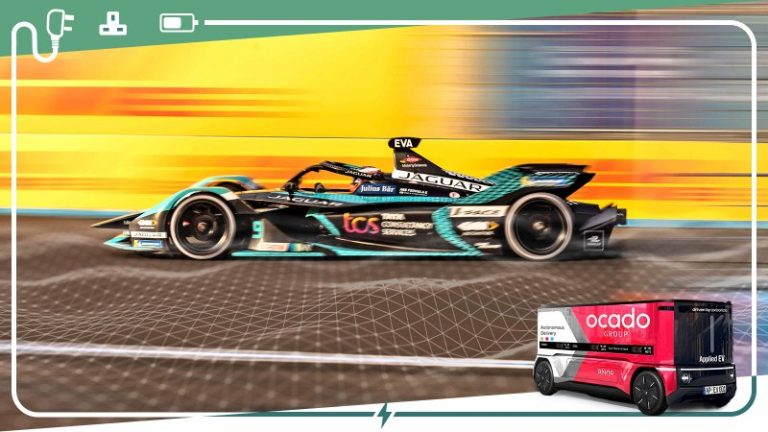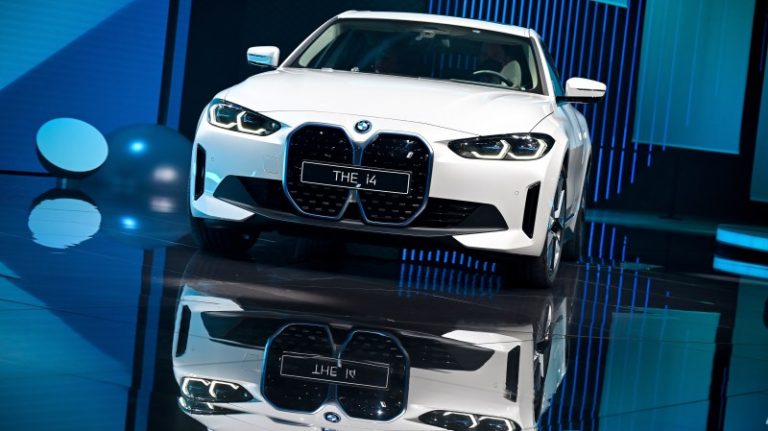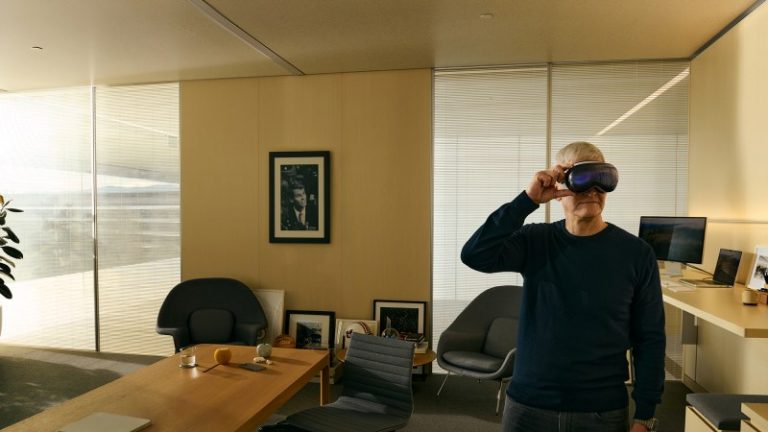Apple Vision Pro release: could VR spell the end for smartphones?
This weekend, all over America, hundreds of thousands of Apple enthusiasts will be unboxing their Vision Pros to step into what the company calls a new era of “spatial computing”. They will be immersed into a home cinema mounted on their faces and have their office screens displayed virtually in front of them, controlling everything with their eyes and hands.
At $3,500, the heavy, expensive device with an external battery that lasts only two hours shouldn’t really have too much of an impact on the wider tech world, given that Meta has been developing similar headsets at a fraction of the cost. But the quality of the Vision Pro experience has reinvigorated the belief that virtual, mixed or augmented reality will have a part to play in our lives.
The release also combines with several developments in the last few months that have prompted observers to reimagine our relationship with the smartphone. The combination of artificial intelligence and smart devices lie at the heart of this shift.
Suddenly these visions don’t feel so far away: walking around with smart glasses that display train times before your eyes, or tell you to speed up your run because your smartwatch says so, or give you visual directions to the museum after a voice request.
Two start-ups have launched AI devices that seek to either replace the phone or work alongside it as a smart assistant. The Humane Ai Pin clips to your clothes and responds to voice commands to make a call, answers queries and projects onto your hand to replace the screen.
The rabbit R1 is a stylish, small square pocketAI assistant that is designed to interact with your apps via voice control to book flights, restaurants and taxis and answer your queries about the world. Although neither the Pin nor the R1 is expected to be a mass consumer device, 50,000 people were curious enough about the R1 to pre-order it.
• I tried the Apple Vision Pro. I was lost for words
Voice is expected to be the heart of our interaction with AI-enabled devices as the new large language models consign our clunky chats with Alexa and Siri to history.
The former Apple design chief Sir Jony Ive is reported to be developing a standalone, screenless AI device with OpenAI’s Sam Altman, dubbed the “iPhone for the AI era”. But with smartphone makers starting to incorporate much of this technology, they have tough competition. Google and Samsung recently packed image recognition and AI translation, transcription and summarising features into their latest phones. Apple is expected to do the same later this year.
AI is also boosting expectations for smart glasses, given their growing power to interpret images. Meta has been testing Ray-Ban smart glasses with cameras and an AI assistant, and Snap and others have been developing augmented reality spectacles that will overlay information in front of the wearer’s eyes.
Will all this mean that phones will one day be redundant? “We will use the phones, but we might not be staring at the screen,” says Carolina Milanesi, president and principal analyst at Creative Strategies, a market intelligence firm.
She believes that AI will gradually anticipate our needs, so for example it books an Uber for you based on your calendar, rather than you doing it for yourself. “That will be done, a lot of it will be done and I don’t have to do it,” she says. “Therefore my interaction with the phones is going to be less, but it’s still going to be the thing that will deliver for me.”

Despite using the Vision Pro for the last week, she is sceptical about the mass adoption of smart glasses. “Even in ten years I don’t see the majority of people dropping something on their faces, even if it’s something as small as the Ray-Ban glasses,” she adds.
Others are more bullish on the prospect of augmented reality. “We are seeing a shift in the way we interact with content,” says Francisco Jeronimo, an analyst at IDC Europe, another market intelligence firm.
“That’s where the promise of the smart glasses and augmented reality and virtual reality come in. You can have a lot more digital content, laid on top of reality and on top of what we see. And that’s the huge benefit … it can give you information in front of your eyes without being too distracting and without you having to look at a phone to get directions or to get additional information.
“That is quite powerful. That’s exactly what the likes of Meta, Apple and many other players are trying to do. To bring that visual world and data in front of our eyes.”
Jeronimo believes the phone will still be here in ten years, acting as the hub for our devices, but predicts the end for another familiar feature: the keyboard. “It is the thing that will probably disappear over time or become really irrelevant because more and more we are using our voice and we will be using our hands with the two cameras [and] they will be able to identify what we want to do.”

For Ben Wood, chief analyst at CCS Insight, any talk of smartphones disappearing is “dangerous territory”. “I think the mobile phone has become such a fundamental device in the fabric of society, it seems to have established itself in such a dominant form, which is just ubiquitous and understood, and familiar and comfortable,” he says.
But he is hoping smart glasses will “deliver against the promise” over the next few years. “Smart glasses that augment my life, but work in this network of connected devices that I have around me. Be that my phone, my watch, my smart ring, my earbuds.”
That network of devices has already become a reality, with our thirst for “wearables” — watches, rings and headphones — seemingly insatiable. Some 148 million were sold in the last three months of 2023 alone, according to IDC, much of it driven by our desire to track our steps, sleep and heart rate.
Wood adds that sight and hearing are “underexploited” senses. “If I could augment my life to the point that I would just get these little prompts and augmentations and nudges within my line of sight, reminding me when I last met someone, telling me that my train is going to be four minutes late, rather than to get my phone out and then drop something or run into a lamppost.”
He does recognise that one of the obstacles is privacy. “The Meta smart glasses are a lightning conductor for privacy issues … you’re walking around with a camera on your face,” he says.
Many remember how Google Glass fell at this hurdle in 2014, but even sceptics like Milanesi believe society has moved on since then. “I think that we are much more used to having things being captured because of phones,” she says.
For those that would rather be seen dead than wearing smart glasses, Milanesi recalls how that was the case for early headphones too. “Most people thought that you were silly, even with AirPods, where you had the white strings coming down your neck and people making fun of you. And then those became an icon. We’re funny. We’re funny creatures.”






